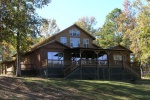SAM RAYBURN RESERVOIR
SAM RAYBURN RESERVOIRRt 3 Box 486 75951
(lat:31.0611 lon:-94.1061)

Phone:
409 384-5716
A 114,000-acre lake in the Big Thicket country of Texas, with native flora including orchids, insect-eating plants and scores of animal species. At 114,000+ acres, Sam Rayburn is the largest man-made lake located totally within the boundaries of the state of Texas. The lake is located deep in the Piney Woods of Southeast Texas, nestled within the Angelina and Sabine National Forest. Sam Rayburn Reservoir is nationally renowned for its large mouth bass fishery, hosting numerous tournaments each year. Recreation opportunities include camping, fishing, swimming, boating, and hunting as well as concessions offered by marinas.
The Sam Rayburn Reservoir, located in Deep East Texas, is a sprawling freshwater lake nestled within the Piney Woods region. This area boasts gently rolling hills covered with dense forests of pine and hardwood trees that provide lush greenery year-round. The reservoir itself was created by impounding the Angelina River and now serves as one of the largest lakes wholly situated within Texas' borders at approximately 114,500 acres (463 km2). Its meandering shoreline stretches for miles offering numerous coves and inlets which are home to diverse wildlife habitats. With its rich aquatic ecosystems featuring submerged vegetation along shallow banks transitioning into deeper waters teeming with fish species such as largemouth bass, this body of water has become an angler's paradise while also providing ample opportunities for boating and recreational activities amidst serene natural landscapes.
Constructed in 1965, the reservoir named after Speaker of the House Sam Rayburn is located in Deep East Texas. The U.S. Army Corps of Engineers built it for flood control, hydroelectric power generation, and recreational purposes.
Prior to its creation as a water conservation project, this area consisted largely of rural farmland and woodlands owned by local residents and timber companies. Some land was acquired through purchase while other parcels were obtained via eminent domain proceedings.
Historically significant features within the park include remnants from early settlers such as old cemeteries tucked away among trees near lake shores-silent witnesses to former communities now submerged or displaced by waters' rise.
The surrounding lands have seen various uses over time including logging activities due to dense pine forests prevalent before inundation; post-creation has witnessed an increase in recreation-oriented development like marinas alongside continued forestry management practices outside designated protected zones around shorelines.


